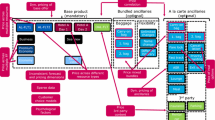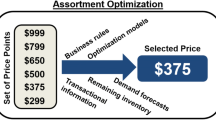Abstract
Today, dynamic pricing (DP) in most industries is an established form of pricing, and supported by the DP functionality of many revenue management (RM) systems and the general simplification of airline pricing driven by low-cost carriers. The technological changes (NDC, Big data, IoT, etc.) allow further steps for price differentiation culminating in either personalized or personalized dynamic pricing (PDP). PDP as we define it is not to be confused with the traditional DP of today‘s RM practices. Whether appropriate strategies for a 1:1 price setting can be successfully implemented in the market, depends on several factors: (1) technological advances in data mining and the ability to detect customer preferences (2) the ability to accurately determine customer’s willingness-to-pay by predictive analytics; (3) the use of personal data by airlines and its acceptance by consumers as well as (4) the medium-term impact on customer loyalty and the associated risks for the sustainability of the whole airline business model.



Similar content being viewed by others
References
Bayraksan, G., H.S. Ahn, and G. Aydin. 2011. Dynamic pricing of limited inventories when customers negotiate. Operations Research 4 (2011): 882–898.
Belobaba, P.P. 2010. Did LCCs save airline revenue management? Journal of Revenue and Pricing Management 10 (1): 19–22.
Bernasek, A., and D.T. Mongan. 2015. All You Can Pay: How Companies Use Our Data to Empty Our Wallets. New York: Nation Books.
Choudhary, V., A. Ghose, T. Mukhopadhyay, and U. Rajan. 2005. Personalized pricing and quality differentiation. Management Science 51 (7): 1120–1130.
CONPOLICY. 2016. Was Verbraucherinnen und Verbraucher in NRW über individualisierte Preise im Online- Handel denken. Abschlussbericht. Aktenzeichen: I-4-2.1-15/085. Gutachten für das vorgelegt beim Ministerium für Klimaschutz, Umwelt, Landwirtschaft, Natur- und Verbraucherschutz (MKULNV) des Landes NRW, Düsseldorf.
Darke, P.R., and C.M.Y. Chung. 2005. Effects of pricing and promotion on consumer perceptions: It depends on how you frame it. Journal of Retailing 81 (1): 35–47.
Executive Office of the President of the US. 2015. Big Data and differential Pricing. Retrieved from https://www.whitehouse.gov/sites/default/files/docs/Big_Data_Report_Nonembargo_v2.pdf. Accessed 10 October 2016.
Friesen, M., and S. Reinecke. 2007. Wahrgenommene Preisfairness bei Revenue Management im Luftverkehr. Marketing Review St. Gallen 24 (4): 34–39.
Friesen, M. 2008. Wahrgenommene Preisfairness bei Revenue Management—eine verhaltenswissenschaftliche und empirisch gestützte Untersuchung der zeitlichen Veränderung im Kaufentscheidungsprozess einer Luftverkehrsdienstleistung. Ph.D. Thesis. Bamberg.
Haws, K.L., and W.O. Bearden. 2006. Dynamic pricing and consumer fairness perceptions. Journal of Consumer Research 33 (12): 304–311.
Kim, J.Y., M. Natter, and M. Spann. 2009. Pay what you want: A new participative pricing mechanism. Journal of Marketing 73 (1): 44–58.
Kimes, S.E. 1994. Perceived Fairness of yield management. The Cornell H.R.A. Quarterly 35: 22–29.
Krämer, A. 2015. Pricing in a VUCA World—How to optimize prices, if the economic, social and legal framework changes rapidly. In Managing in a VUCA World, ed. O. Mack, et al., 115–128. New York: Springer.
Krämer, A., and T. Burgartz. 2016. Controlling von innovativen Preismodellen—Status Quo, Anforderungen und praktische Umsetzung am Beispiel “Pay-What-You Want”. Controlling 28 (6): 325–337.
Krämer, A., and R. Kalka. 2016. How Digital disruption changes pricing strategies and price models. In Phantom Ex Machina: Digital Disruption’s Role in Business Model Transformation, ed. A. Khare, R. Schatz, and B. Stewart, 87–103. New York: Springer.
Lamberton, C., and A.T. Stephen. 2016. A thematic exploration of digital, social media, and mobile marketing: Research evolution from 2000 to 2015 and an agenda for future inquiry. Journal of Marketing 80 (6): 146–172.
Martin, K.D., A. Borah, and R.W. Palmatier. 2016. The Dark Side of Big Data’s Effect on Firm Performance. Marketing Science Institute Working Paper Series 2016 Report No. 16-104.
McMahon-Beattie, U. 2011. Trust, fairness and justice in revenue management: Creating value for the consumer. Journal of Revenue & Pricing Management 10 (1): 44–46.
O’Connell, J.F., and D. Warnock-Smith. 2013. An investigation into traveler preferences and acceptance levels of airline ancillary revenues. Journal of Air Transport Management 33 (2013): 12–21.
Office of Fair Trading. 2013. Personalized Pricing - Increasing Transparency to Improve Trust. Retrieved from http://webarchive.nationalarchives.gov.uk/20140402142426/http:/www.oft.gov.uk/shared_oft/markets-work/personalised-pricing/oft1489.pdf. Accessed 10 October 2016.
Rosenstein, D.E. 2013. The Changing Low-Cost Airline Model: An Analysis of Spirit Airlines. Lafayette: Purdue University.
Sanburn, J. 2012. Delta appeared to overcharge frequent flyers for weeks-was that legal? Retrieved from http://moneyland.time.com/2012/05/21/delta-overcharged-frequent-flyers-for-weeks-was-that-legal/.
Turow, J., L. Feldman, and K. Meltzer. 2005. Open to exploitation: American shoppers online and offline. Annenberg Public Policy Center Report.
Valentino-Devries, J., J. Singer-Vine, and A. Soltani. 2012. Websites Vary Prices, Deals Based on Users’ Information, Wall Street Journal, Dec. 24, 2012.
Weisstein, F.L., K.B. Monroe, and M. Kukar-Kinney. 2013. Effects of price framing on consumers’ perceptions of online dynamic pricing practices. Journal of the Academy of Marketing Science 41 (5): 501–514.
Wirtz, J., and S.E. Kimes. 2007. The moderating role of familiarity in fairness perceptions of revenue management pricing. Journal of Service Research 9 (3): 229–240.
Author information
Authors and Affiliations
Corresponding author
Rights and permissions
About this article
Cite this article
Krämer, A., Friesen, M. & Shelton, T. Are airline passengers ready for personalized dynamic pricing? A study of German consumers. J Revenue Pricing Manag 17, 115–120 (2018). https://doi.org/10.1057/s41272-017-0122-0
Revised:
Published:
Issue Date:
DOI: https://doi.org/10.1057/s41272-017-0122-0




